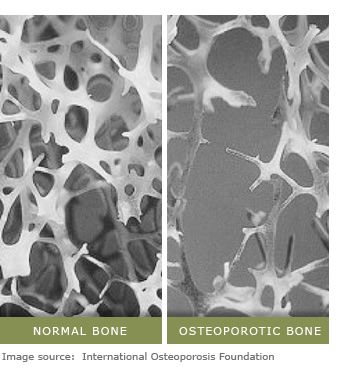Who is at risk?
Can you answer YES to any of these questions?
- Have your periods stopped?
- Does your diet lack Calcium or Vitamin D?
- Do you have an inactive lifestyle?
- Do you use steroids, thyroid or anti-seizure medications?
- Do you have a thin or small frame?
- Do you have a family history of osteoporosis?
- Are you of Caucasian or Asian descent?
- Do you smoke or drink alcohol excessively?
If you answered ‘yes’ to any of these questions, you may be at risk for developing osteoporosis or osteopenia (low bone density).
What is osteoporosis?
Osteoporosis is the most prevalent of the bone diseases that affect Americans. One out of every two women and one in eight men will have an osteoporotic fracture in their lifetime. 28 million Americans have either osteoporosis or osteopenia, which increases risk of fracture, pain and significant loss of function and quality of life. A woman’s risk of hip fracture is greater than her risk of breast, uterine and ovarian cancer.
Osteoporosis is the thinning of bone tissue resulting in loss of bone density. Bone is living tissue that is continually being broken down as well as replaced with new bone. Osteoporosis occurs when bone is lost faster than it can be replaced.
As bones become more fragile, they are more likely to break. Osteoporosis is a silent disease because it can progress without symptoms or pain until a bone breaks. Severe compromise of bone density is found in younger populations due to poor nutrition, increased carbonated beverage intake, amenorrhea (absence of periods), eating disorders or excessive exercise. The simultaneous conditions of eating disorders, amenorrhea and excessive exercise are called The Female Triad and can result in profound risk in bone density in women throughout the lifespan.
The main factors which contribute to osteoporosis are:
- Faster rate of bone loss after menopause or amenorrhea
- Poor bone growth during childhood and adolescence resulting in lower peak bone mass
- Bone loss due to eating disorders, medications or diseases.

Benefits of Exercise
Research has shown that specific weight-bearing or resistance exercises can:
- Improve bone density and lower risk of fracture
- Decrease pain
- Improve posture by decreasing or slowing the progression of thoracic kyphosis (rounding of upper spine giving a stooped appearance)
- Improve balance and coordination
- Decrease risk of falling
- Increase mobility
Your Bone Health
CorePhysio knowledgeable clinical staff assesses your individual needs and medical history to design a customized treatment program to optimize your bone health. Your therapist will evaluate:
- Postural alignment
- Overall musculoskeletal system
- Body mechanics (the way you move in your daily tasks)
- Balance
Based on evaluation findings, we will design an exercise program designed especially for you. You will learn how to safely perform your exercises and how to minimize your risk of fractures during daily activities.
Finally, if you participate in a gym or community exercise program such as Tai Chi or yoga, you will be given guidance that will help you avoid potential injury or risk of fracture. If you have difficulty with balance, you will be educated in methods to reduce your risk of falling as well as exercises to improve your balance.
OUR SERVICES
Learn more about the many services we offer including Concussion Management, Vertigo and Balance, Women's Health, and more.
OUR SERVICES
Learn MoreCONTACT US
We are committed to helping you recover and restore health. For more information about our physical therapy services please contact us at 360-752-2673.


